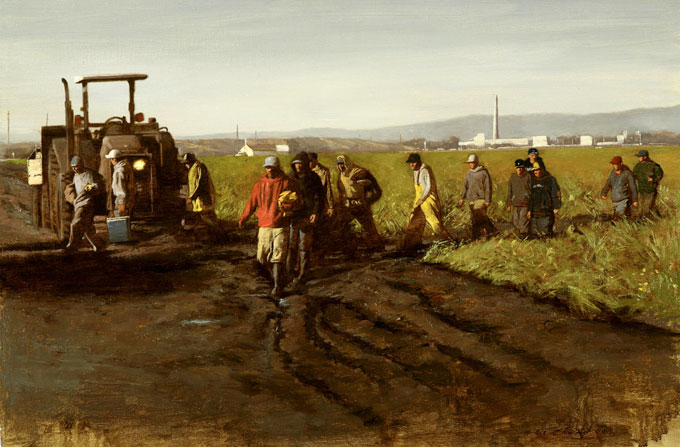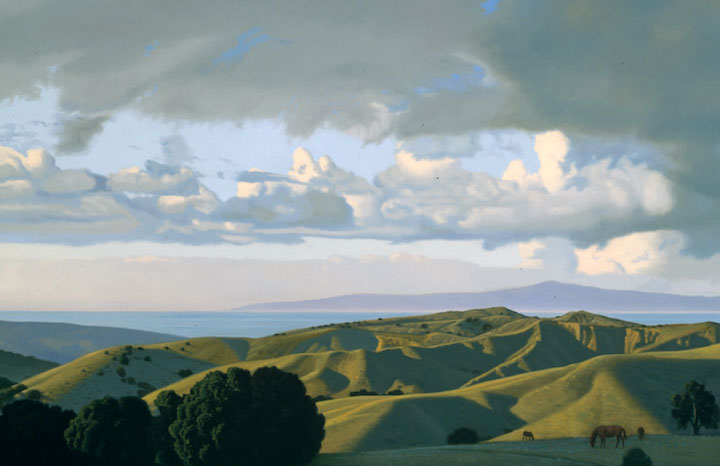Although I have read and enjoyed most of John Steinbeck’s published writing, I am not a Steinbeck scholar and claim no special expertise. But I have lived in California’s Monterey County since 1950, and for many years I taught and coached in Salinas, the town where Steinbeck was born, went to school, and found religious meaning attending a local church. In a sense he never left, and my interpretation and appreciation of his work are colored by the land he lived on—the Salinas Valley and the Monterey Peninsula—and the people he wrote about: the poor and “the salt of the earth,” many of whom (to quote the Sermon on the Mount in the King James Version that Steinbeck read) had “lost their savour.”
In a sense Steinbeck never left Salinas or Monterey, and my interpretation and appreciation of his work are colored by the land he lived on and the people he wrote about.
Walking the hills and observing the vistas of Monterey County—from Fremont’s Peak in the Gabilans east of Salinas, to Mount Toro and the Corral de Tierra (the “pastures of heaven” where I now live), to Presidio Ridge in Monterey—these places have affected me deeply as I think they did John Steinbeck. Likewise, looking at the underground Salinas River from the East Garrison bluffs on the site of the former Fort Ord, where Steinbeck may have walked, suggests to me an undercurrent in the lives of the people who have lived on the surface of this land. Unavoidable, and taken for granted in Steinbeck’s time, were the sounds and smells and sights of Monterey Bay, of Cannery Row, of Fisherman’s Wharf, of lower Alvarado Street, of the Rodeo grounds in Salinas during Big Week, which he always enjoyed. Each one added to the grist and flavor of the characters and stories Steinbeck created or recreated in his fiction. I keep coming back to this all-encompassing environment when I read about his characters. These people were close to the earth.
I keep coming back to this all-encompassing environment when I read about his characters. These people were close to the earth.
As an impressionable boy in Salinas, Steinbeck observed poor Mexicans doing stoop labor in the fertile fields of the Long Valley near town, often alongside their children, who should have been in school. This experience prepared him to empathize with the legions of poor Americans looking for jobs in California in the 1930s—with the Dust Bowl farm families displaced by drought and economic depression who populate The Grapes of Wrath, with the unemployed single men moving from ranch to ranch and harvest to harvest in Of Mice and Men and In Dubious Battle.
In the End Melancholy Lifts, Like the Monterey County Fog
During my time teaching and coaching in the schools of Steinbeck’s home town, I interacted with the children and grandchildren of these people. I don’t see “Okies” anymore, but increasingly I do see down-and-out people standing on the corner in downtown Salinas with cardboard signs asking for work or money. The harsh realities faced by rural and small town Americans prior to World War II—the displaced Americans poignantly painted on Steinbeck’s word canvases—seem to have returned. Other vestiges of Steinbeck’s California can be found if one takes the time to walk, look, and listen to the land and the people on whose behalf Steinbeck’s books still bear witness: the emigrants and the immigrants, the homeless and the lonely, the powerless, and those whose lives lack spiritual or religious meaning.
Vestiges of Steinbeck’s California can be found if one takes the time to walk, look, and listen to the land and the people on whose behalf Steinbeck’s books still bear witness.
Read the books, then walk the land—the Monterey County of The Red Pony, Cannery Row, Tortilla Flat, The Pastures of Heaven, Of Mice and Men, East of Eden and The Long Valley; the sister valleys of The Wayward Bus, In Dubious Battle, and To a God Unknown. The living land evoked by Steinbeck largely remains. So does the emotional and thematic undercurrent that runs like a river through the lives of his characters. Many are spiritually, educationally, economically, or socially disadvantaged, unhinged, or bereft. Some find religious meaning. Most do not.
The living land evoked by Steinbeck largely remains. So does the emotional and thematic undercurrent that runs like a river through the lives of his characters.
My reading reveals a human dynamic in Steinbeck’s characters mirroring that of the land they inhabit, sometimes barely: drought followed by flood; summers of suffering followed by winters of discontent; deserts of isolation broken by moments of sustaining humanity that I would call Christian charity. Often melancholy rolls in like the morning fog. But the fog breaks eventually, and Steinbeck’s endings, though rarely happy, always seem hopeful to me.
Day’s End, oil on canvas by Warren Chang, 20” x 30” (2008), courtesy of the artist. ©Warren Chang.
Landscape with a Red Pony, oil on canvas by David Ligare, 32” x 48” (1999), courtesy of the artist. ©David Ligare.




A fine piece by Mr. Miller reminding us that human needs remain much the same as Steinbeck wrote of them decades ago, accompanied by the work of two superb artists – Davd Ligare and Warren Chang – whose work often reflects the Steinbeck legacy.
An excellent article worthy of invoking deeper thought, for sure. Being the author’s (Ron Miller) brother may, or may not, be a basis of some bias..but I think not.
Very nicely done.
You are your brother’s tweeter!
Great article Ron. As Kenny mentioned definitely “worthy of invoking deeper thought ” and further discussion. Makes me appreciate this beautiful area we are blessed to call home even more and to look after her people.